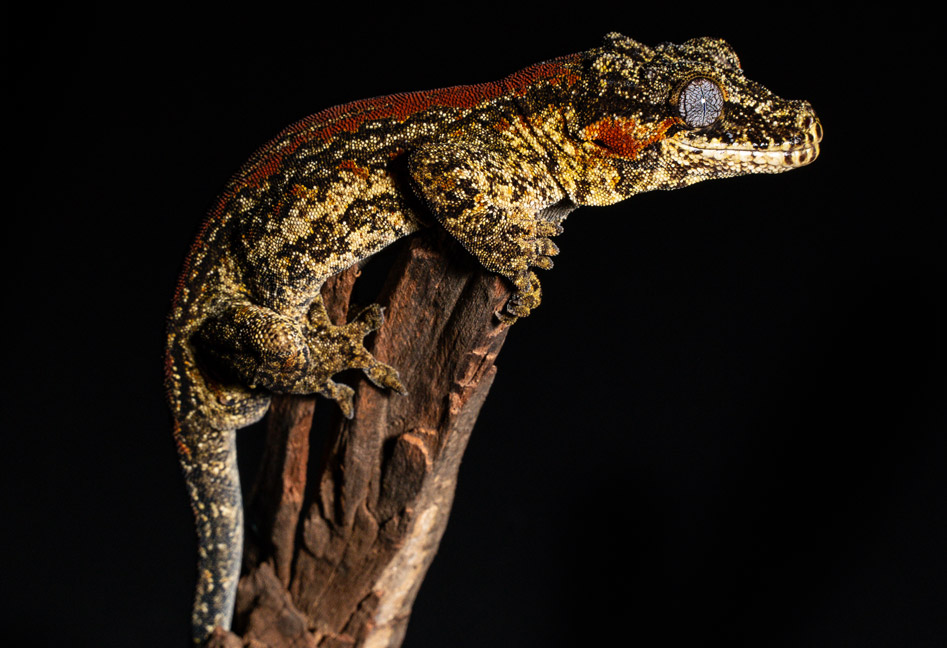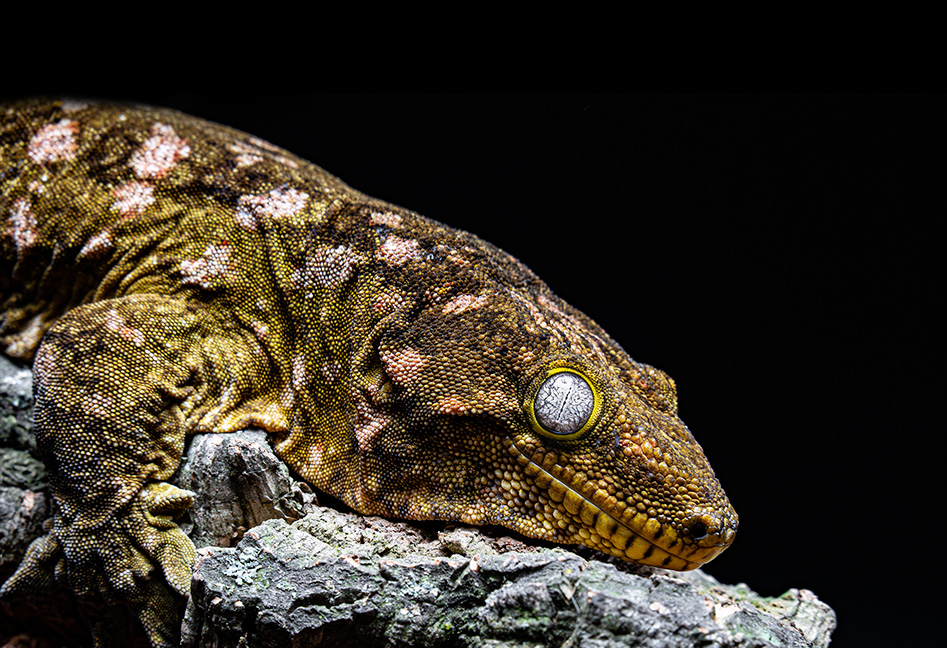Keeping
Crested gecko, gargoyle, sarasinorum and chahoua
Origin
All species of Correlophus y Rhacodactylus are native to the island of New Caledonia, located in eastern Australia. Originally it was thought that crested geckos (Correlophus ciliatus) were extinct until a few specimens were sighted and captured after a tropical storm in 1994.
New Caledonian geckos have proven to be one of the most chromatically variable lizard species in the reptile world. The immense variety of shapes and ease of care have made these animals one of the best exotic pets that can be kept in captivity.
Housing
New Caledonian geckos are semi-arboreal lizards that spend most of their lives in the canopy of low trees. This is why these geckos need a large amount of branches and plants for climbing. They can be kept in simple set-ups (absorbent paper substrate, PVC tubes, egg cartons, etc.) or in a more elaborate bioactive terrarium (peat substrate with microfauna, cork bark, live plants, etc.).
Hatchlings up to six months old can be kept in a tupper the size of a shoebox (about 3-4 liters) or in 20x20x30cm terrariums. It is not advisable to keep them in large terrariums because they tend to have problems finding food and it will be more difficult for us to keep them under control.
Generally, after a gecko reaches 10-15 grams, it will do best in an enclosure of 30x30x50cm (about 50 liters). Adults of average size (40-50 grams) can be kept in 40x40x50cm terrariums. However, there are geckos that due to their genetics reach a larger size (60-80 gr) and should be housed in a terrarium of at least 40x40x60cm or 50x50x60cm. Since they are arboreal creatures, the height of the terrarium is more important than the length.
A pair can be housed in a 50x50x60cm terrarium or larger if females are added to the group. No more than 1 male per group should be kept.
Temperature and illumination
These geckos need daytime temperatures of 23-24ºC (with a 27ºC zone) and nighttime temperatures of 20-21ºC. It is important for the animal's biorhythms to have diurnal rises and nocturnal drops in temperature. During the day usually with a LED spotlight on the top of the terrarium will be enough to give it a slightly warmer zone and at night it would be enough to turn off that spotlight. If the ambient temperature of your house drops below 18ºC at night it would be advisable to add a soft heat source such as a ceramic bulb or a heating cable to avoid an excessive drop in temperature that could be harmful to our gecko.
They do not need UVB light as long as they are supplemented with vitamin D3, but our experience tells us that they are animals that enjoy basking under a low radiation index screen (6%). UVB is the animals' natural way of doing good calcium metabolism, as well as many benefits associated with natural behavior. We always recommend adding UVB screens to our terrariums, although strictly speaking they may not need them.
Humidity
These geckos require a moderate humidity of 60% to 85%. This can be easily achieved and maintained with one or two spraying sessions each day and a container of water inside the terrarium. An automatic rain system will ease the task of maintaining good humidity levels.
Keep in mind that the amount of time and number of times per day you spray will depend on the type of enclosure in which the geckos are kept. If your setup is naturalized, densely planted with a generous layer of substrate, the ambient humidity will practically maintain itself thanks to the transpiration of the plants. If, on the other hand, you have a more practical terrarium, with absorbent paper as substrate and some branches and artificial plants, the humidity will tend to be lower and you will have to water more frequently.
Another variable to take into account is where you live. If you are from a coastal area and the environment is generally humid you will have to spray less often than if you live in drier inland areas. Remember, these are not amphibians, so the enclosure should be moist but not waterlogged.
Feeding
The best way to feed these New Caledonian geckos and keep them healthy would be to combine a diet based on powdered preparations and live insects.
There are many products on the market designed exclusively for feeding geckos. Preparations based on fruit, vitamins and in many cases insect meals. Brands such as Gecko Nutrition, Rhacofood diets, Repashy superfoods, Pangea,... are easy to find in stores specialized in exotics.
In Kanaky Reptiles we feed our newborns and juveniles 2 times a week with chow and 2 times with live food (being a mixed day of chow and live insects) and the adults 2 times chow and 1 live food. Younger animals can be offered food more frequently as long as they accept it, but it is not recommended to do this with adults because it can lead to obesity problems.
The Mniarogekko chahoua usually have a greater appetite for live food than other geckos, and a greater protein intake will help their development. If live insects can be fed more times a week, so much the better.
If you don't want to have to feed live insects in the terrarium, you can grind up frozen insects beforehand and add them to the slurry to give them that extra protein. Animals fed regularly with insects will grow faster and healthier than those that have only eaten ready-made food. It is necessary to avoid making homemade fruit mashes since they will almost certainly be deficient in many of the vitamins and nutrients necessary for the good life of these animals.
Insects such as crickets or cockroaches are the easiest to obtain and some of the best nutritionally speaking. We do not recommend the continued use of larvae such as tenebrio or zophoba. The insects offered should not be larger than the width of the gecko's head to avoid choking. When in doubt, it is better to offer a smaller insect and let it eat several.
With every live insect feeding it is essential to sprinkle with calcium and vitamin D3 supplements.
Although not crucial, we recommend providing these geckos with a container of water. Generally, crested geckos drink water by licking drops that remain on the terrarium walls, leaves or other decorative elements. However, these animals can also hydrate themselves through the cloaca. This is why it is common to find poop in the water. The animals get into the container and the water stimulates them to expel feces. If a container with water is placed in it, it is essential to change it whenever waste is seen in it, otherwise it can become a breeding ground for numerous bacteria that could generate an infection in the gecko.
If you are not going to be responsible with this issue, it is better not to put a bowl with water.
Decoration and substrates
There are many decoration options for terrariums, from the simplest with absorbent paper and some branches to the most complex bioactive set-ups.
For small animals we recommend keeping them initially in absorbent paper to keep them in a cleaner place, with less risk of infection and where we can control it better. This does not mean that it is not possible to keep them in more naturalized environments, but for inexperienced breeders it would be ideal to look for less complications.
For larger animals we recommend more elaborate decorations to provide environmental enrichment and keep the animals mentally active, which will help them lead a full life.
Personally we prefer decorations that can be easily disassembled, without being glued to the bottom, as they are animals that dirty terrariums relatively quickly and being able to access for cleaning is very important. The decorative elements must be properly seated in the terrarium to avoid falls when the gecko is jumping from one place to another, as well as the plants that are placed have to be very hard as Pothos, Cheflera, Sanseviera, Croton, Monstera, ... plants that will withstand the high activity of the geckos at night.
As substrate, mixtures of coir fiber, coir chips and blond peat work very well for bioactive terrariums.
Cohabing
Cohabitation, as it is often called, is keeping more than one gecko in the same terrarium. You have probably heard a lot of misinformation about this that says you should never do this and your geckos will die, but this is simply not true. Cohabitation can be done easily and without problems, but it should still be done with caution. Two males should never be together as they will most likely fight to the death. Adult females of approximately the same size can be kept together with little problem except in the case of M. chahoua we recommend always keeping them in pairs. However, it is important to keep an eye on the geckos to ensure that harassment does not occur. Some ways to prevent this from happening is to provide an enclosure large enough for the number of females you wish to keep together. It is also important to provide sufficient cover and hiding places when you have multiple animals within the same terrarium. Providing the right amount of food and water is also critical for geckos when living together. If this is your first time keeping geckos, it is best to avoid keeping them together, it will save you trouble.






